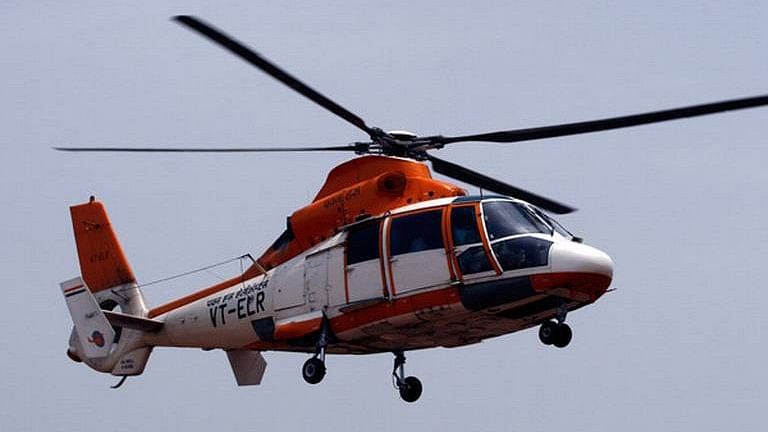
Representative image of Pawan Hans chopper.
Credit: X/@airnewsalerts
Pilots' lack of familiarisation with automatic flight control systems was one of the contributing factors that led to Pawan Hans' Sikorsky helicopter crash that killed four people off the Mumbai coast in June last year, according to an investigation report that has also called for various corrective measures.
In its final report on the accident involving Sikorsky S-76D helicopter that was operated by Pawan Hans, the Aircraft Accident Investigation Bureau (AAIB) has also flagged that the passenger safety briefing video did not provide correct guidance for inflation of life jackets.
Out of the seven people who were onboard the chopper, the report said that all of them evacuated from the helicopter but only five could inflate the life jackets.
The helicopter was to operate a crew change sortie to ONGC-operated Sagar Kiran Rig in Mumbai off-shore.
The accident happened on June 28, 2022, as the helicopter entered into uncontrolled flight during its final approach and fell into the sea.
According to the AAIB, there was undesired aggressive nose up maneuver coupled with full lowering of the collective by pilot flying, which resulted in steep autorotative descent at near zero speed leading to impact with sea.
The AAIB cited a "lack of familiarisation and proficiency on use of the aircraft's AFCS (Automatic Flight Control Systems), which led to inappropriate handling of controls' as one of the contributing factors for the accident."
Another contributing factor was the absence of monitoring by pilot due to involvement with switching-off of weather radar during crucial phase of flight leading to delayed take-over in an emergency.
"The flight control inputs made by the co-pilot were inconsistent for a stabilised approach and the landing profiles outlined in the RFM (Rotorcraft Flight Manual), which requires a vertical profile of 300 FPM (Feet Per Minute) or less during the approach to landing."
"The pilots may not have understood or been proficient using the basic AFCS," the report said.
Further, it noted that the description of life jacket in passenger safety briefing card approved by the Directorate General of Civil Aviation (DGCA) was not matching the type of life jacket that was placed on the helicopter.
"Pawan Hans did not initiate any action to get amendments incorporated in the passenger safety briefing card until endorsement of S-76D on AOP, even though these life jackets were available with Pawan Hans since December 2020 and had been used during proving flight and other non-revenue flights before endorsement."
"It took Pawan Hans another four months after S-76D endorsement on AOP (Air Operator Permit) to get the revision of the passenger briefing card approved by DGCA," it added.
In a raft of safety recommendations, the report said that DGCA should review Civil Aviation Requirements (CAR) on Flight Data Analysis Programme (FDAP) to provide additional guidance to helicopter operators in terms of adverse operational events and operations related parameters.
"DGCA should revise the CAR on the subject to include a minimum experience on the new type specifically in the offshore role. The regulations should clearly define the minimum experience in such a way that at least one pilot on board with adequate role experience on the new type is available in the cockpit during offshore operations," it said.
The aviation regulator has also been asked to carry out one time audit of all operators to verify that passenger safety briefing cards used by the operators are in consonance with actual equipment available on aircraft.
"DGCA should carry out one time audit of operators, who are using passenger safety briefing videos, to verify that there is no anomaly in safety and emergency procedures being shown in the video," the report said.
The AAIB noted that the rescue boat of Sagar Kiran was unserviceable and the life boat was designated to be used for rescue role with limitations to not carry more than 06 occupants in rescue role. On the day of the accident, eight rescuers went to sea for rescue operation on the rescue boat, it added.
Further, the report said that ONGC should ensure serviceability of all safety, communication and rescue equipment on its rigs and vessels.
Pawan Hans should emphasise use of the basic AFCS functions during normal flying operations by the pilots. It should also ensure that the executive nominated to DGCA as accountable executive or other post holders have adequate experience in civil aviation and ability to put resources and authority at their disposal to achieve complete inter-departmental and inter-disciplinary coordination, as per the report.